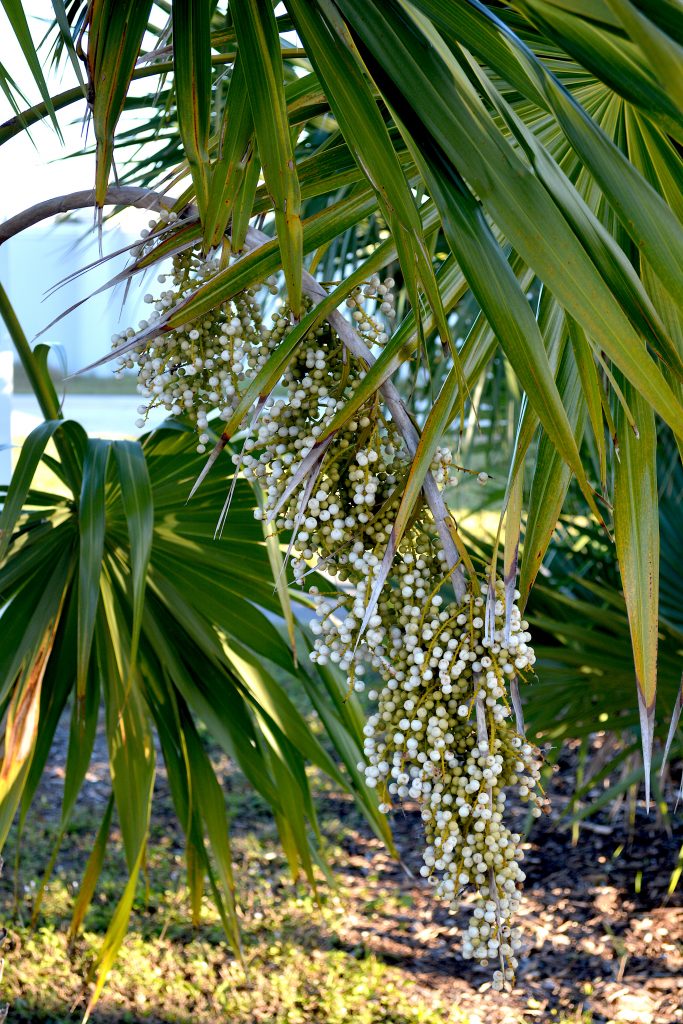
The white fruit of the Thrinax radiata… I think… Photo by Green Deane
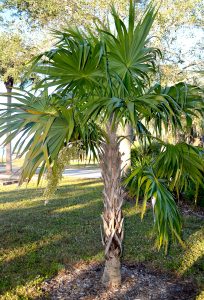
The Florida Thatch Palm might be found more in landscaping than in nature.
At what point does a “wild” plant become an edible plant? Good question. Occasionally on teaching trips to south Florida I saw a palm with small white fruit. Twice I tasted them. No particular flavor but more importantly no burning from calcium oxalates (which is usually the first sign a palm fruit is not edible.) On my last trip I took some pictures aiming for identification. What I got tentatively was Thrinax radiata, the Florida Thatch Palm, so called because it was used to thatch hut roofs. Thrinax by the way means “trident” in Greek, radiata radiating. If the identification is correct then are the fruit edible? On page 670 of Florida Ethnobotany by Daniel Austin he writes: “Fruits are sweet and edible.” Then he says “the fiber has been used to stuff pillows and mattresses.” So if this is the right identification I might be able to add one more edible to the list.
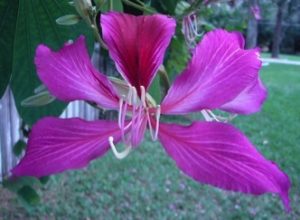
Orchid Tree blossoms are edible. Photo by Green Deane
We saw several species blooming this past weekend in my foraging class. The Hibiscus were happy including the “Sleepy Hibiscus.” It’s a fairly easy shrub to identify because the bright red blossoms never unfurl. Also blossoming was the Bauhinia. It’s a tree that is both easy and challenging at the same time. The blossoms are edible, look nice in salads. Some of the species have edible seeds and some do not. (They are in the pea family and most pea trees — most not all — do not have edible seeds.) Sorting out which Bauhinia you have can be a challenge, nearly as bad as sorting out which Cereus you have. Like the Cereus cactus there are several man-made hybrids and perhaps even some fake botanical names. It can make species identification a real headache though as far as I know all the blossoms are edible. Only “discovered” 111 years ago the blossom of the Bauhinia blakeana is the emblem of Hong Kong. You can read about the Bauhinia here.

Classes are held rain or shine or cold. (Hurricanes are an exception.) Photo by Kelly Fagan.
Foraging Classes: Only two foraging classes in the next two weeks so you can concentrate on the holidays. This Sunday is a class in St. Petersburg at Ft. Desoto, a location we visit perhaps three times a year. We start beach side near the fishing pier so if it is cool or windy dress warmly.
Sunday, December 27th, Ft. Desoto Park, 3500 Pinellas Bayway S. St. Petersburg Fl 33715. 9 a.m. to noon. There is an entrance fee to the park. After you enter the park you arrive at a T-intersection. Turn right. Close to a mile later on your left is the fishing pier and parking lot. Meet near the bathrooms. There is considerable walking at this location.
Sunday, January 3rd, Jervey Gantt Recreation Complex, 2390 SE 36th Ave., Ocala, FL, 34471. 9 a.m to noon. Meet at the entrance to the pool, aka Aquatic Fun Center. There is no fee for this class. However, if you want to make a donation afterwards that’s up to you.
For more information, to prepay or to sign up go here.
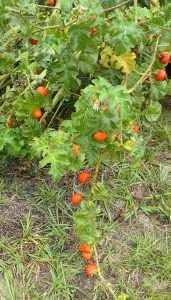
Tropical Soda Apple. Photo by Green Deane
No. It is not edible. No. It is not medicinal. Well… maybe it is medicinal, and if anyone says it is edible I ain’t going to try it.
Locally you can see two different “Horse Nettles” this time of year, neither are proven edible as far as I know. One has red fruit, the other yellow (and that can vary, too.) The latter is Solanum Carolinense and that is definitely off limits. Toxic. The former, Solanum ciliatum is more iffy. It’s also called a Cockroach Berry Soda Apple or the Tropical Soda Apple though that is usually a different species, S. viarum.)
The first problem is S. ciliatum is not native. How it got to the United States is a good guess. Some think the seeds arrived in the intestional track of cattle from South America. The second problem is some members of this family grow more toxic as they age while others grow less toxic. There are reports of S. ciliatum being used medicinally for things like rheumatism, arthritis, and skin diseases. It does contain steroidal alkaloids. It has also poisoned cattle and sheep (which makes one wonder if it is that toxic to cattle why do they think it was imported in the dung of cattle? However, it might be that leaves and fruit have different toxicities. The poisoning could have come from leaves or green fruit while the ripe fruit seeds were just non-digested hitchhikers.) The third problem is the plant itself has had well over a dozen botanical names, close to a dozen and a half actually. That makes it difficult to know what plant is actually being discussed and if the traits attributed to it are really about that plant.
The worse problem is that about a decade ago I found an American university publication that listed the species as edible. Do not try to eat it because that is just too iffy for a plant that is also widely reported as highly toxic and fatal, especially the green fruit. I suspect the university botany department was just as confused regarding the identification of the plant as are others. What I wonder about is the ripe fruit. I’ve never seen any credible reference with the necessary details. What I would like to know is what if anything did Brazilian natives do with the plant? That could be a credible reference. Perhaps some of our Portuguese speakers can find that out. Indeed, on one Brazilian site it says (if the translation is to be trusted) “every child ate that fruit” and “consumption can only eat the skin with a thin layer of meat. The seeds are bitter and are not intended for consumption. The rind of the fruit can also be used in cooking, using it just like chili.” But… is it the same species? I am not going to try.
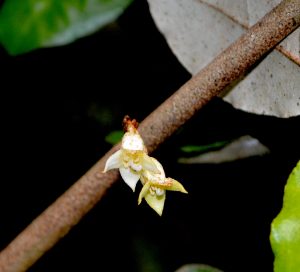
Silverthorn blossoms are boxy. Photo by Green Deae
Foragers benefit from bad ideas. One of those is taking plants from one place on earth to another. We harvest and eat a lot of local plants that came from somewhere else. One of them is so far from home that it fruits in February.
The Silverthorn is native to Southeast Asia. It came to North America as an ornamental about 200 years ago. Early botanists were sure it would not become an invasive pest because they said the fruit were not nutritious for birds. Thus the birds would not eat them and spread the seeds around. The problem is no one told the birds that (and if birds did not spread the seeds around in Asia, what did?) In some areas the Silverthorn is an invasive species and forbidden. In other areas it is still sold as an ornamental. We call it tasty.
While the Silverthorn fruits around February now is the time to be looking for the shrub and blossoms. The bush hides the blossoms and they are a bit strange looking, if not futuristic. The four-petaled speckled blossom turns into a red jelly bean-like fruit with gold and silver speckles. They are bitter and sour until ripe. The shelled seed is also edible. Altogether the fruit is high in vitamin C, lycopene, and Omega 3 fatty acids. And that is a tasty treat in the middle of winter. To read more about the Silverthorn go here.

Green Deane videos are now available on a USB.
A 150-video USB or 135 video DVD set would be a good winter present and either is now $99. My nine-DVD set of 135 videos has been selling for seven years and are still available. They are the same videos I have on You Tube. Some people like to have a separate copy. A second option is a16-gig USB that has those 135 videos plus 15 more. While the videos can be run from the DVDs the videos on the USB have to be copied to your computer to play. They are MP4 files. The150-video USB is $99 and the 135-video DVD set is now $99. The DVDs will be sold until they run out then will be exclusively replaced by the USB. This is a change I’ve been trying to make for several years. So if you have been wanting the 135-video DVD set order it now as the price is reduced and the supply limited. Or you can order the USB. My headache is getting my WordPress Order page changed to reflect these changes. We’ve been working on it for several months. However, if you want to order now either the USB or the DVD set make a $99 “donation” using the link at the bottom of this page or here. That order form provides me with your address, the amount — $99 — tells me it is not a donation and in the note say if you want the DVD set or the USB.

Green Deane Forum
Want to identify a plant? Perhaps you’re looking for a foraging reference? You might have a UFO, an Unidentified Flowering Object, you want identified. On the Green Deane Forum we — including Green Deane and others from around the world — chat about foraging all year. And it’s not just about warm-weather plants or just North American flora. Many nations share common weeds so there’s a lot to talk. There’s also more than weeds. The reference section has information for foraging around the world. There are also articles on food preservation, and forgotten skills from making bows to fermenting food.
This is weekly newsletter #437. If you want to subscribe to this free newsletter you can find the sign-up form in the menu at the top of the page.
To donate to the Green Deane Newsletter click here.

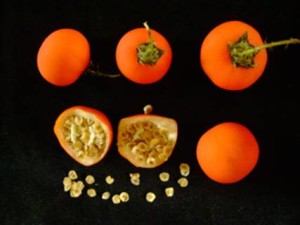
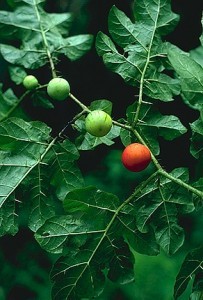

Merry Christmas, Green!
Awesome!